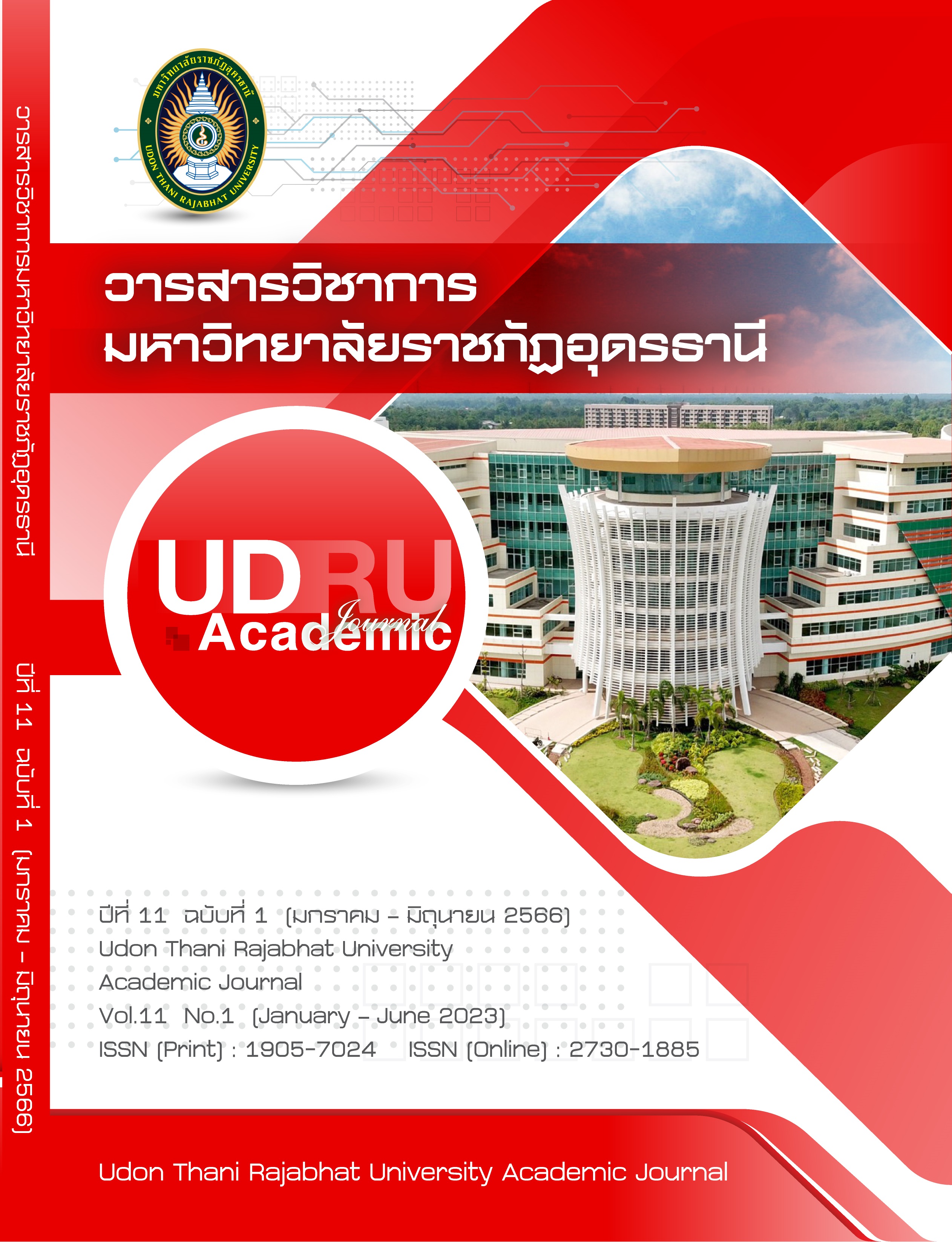A Study of English Language Learning Strategies of Undergraduate Students of the Faculty of Interdisciplinary Studies at Khon Kaen University
Main Article Content
บทคัดย่อ
ภาษาอังกฤษ เป็นภาษาทางการที่ถูกใช้ในหลายๆประเทศ ไม่เฉพาะประเทศที่ใช้ภาษาอังกฤษเป็นภาษาแม่ ยังรวมไปถึงประเทศที่ใช้ภาษาอังกฤษเป็นภาษาที่สอง และประเทศที่ใช้ภาษาอังกฤษในฐานะภาษาอื่นอีกด้วย คริสตรัล (2003: 1-10) กล่าวว่า ภาษาอังกฤษเป็นภาษาอันดับต้นๆ ของโลก เนื่องจากมันถูกใช้อย่างแพร่หลายไปทั่วโลก ดังนั้น ประชากรในกลุ่มประเทศที่ใช้ภาษาอังกฤษเป็นภาษาที่สองและกลุ่มประเทศที่ใช้ภาษาอังกฤษในฐานะภาษาอื่น จำเป็นต้องเรียนรู้และพัฒนาภาษาอังกฤษเพื่อใช้ในการติดต่อสื่อสารและอื่นๆ ที่จำเป็น บทความนี้มีวัตถุประสงค์เพื่อ ศึกษากลยุทธ์การเรียนรู้ภาษาอังกฤษของนักศึกษาระดับปริญญาตรี คณะสหวิทยาการ มหาวิทยลัยขอนแก่น ประเทศไทย จำนวน 310 คน โดยตัวแปรที่ต้องการศึกษาได้แก่ 1) เพศ 2) สาขาวิชา และ 3) ระดับความสามารถทางภาษาอังกฤษ เปรียบเทียบกับกลยุทธ์การเรียนรู้ภาษาสำหรับผู้เรียนภาษาอังกฤษในฐานะภาษาอื่น ซึ่งแบ่งออกเป็น 6กลยุทธ์ ได้แก่ 1) กลยุทธ์ด้านความจำ 2) กลยุทธ์ด้านปัญญา 3) กลยุทธ์ด้านการชดเชย 4) กลยุทธ์ด้านอภิปัญญา 5) กลยุทธ์ด้านอารมณ์ และ 6) กลยุทธ์ด้านสังคม โดยใช้เครื่องมือแบบสอบถามกลยุทธ์การเรียนรู้ภาษา SILL version 7.0 (ESL/EFL) Oxford (1990) พร้อมทั้งใช้แบบสัมภาษณ์กึ่งโครงสร้าง เพื่อเก็บข้อมูลกลยุทธ์การเรียนรู้ อังกฤษตามแบบฉบับของตัวบุคคลอีกด้วย ผลการศึกษาพบว่า 1) เพศไม่มีความแตกต่างกันในการใช้กลยุทธ์การเรียนรู้ภาษาอังกฤษ 2) สาขาวิชามีความแตกต่างกันในการใช้กลยุทธ์การเรียนรู้ภาษาอังกฤษ และ 3) ระดับความสามารถทางภาษาอังกฤษมีความแตกต่างกันในการใช้กลยุทธ์การเรียนรู้ภาษาอังกฤษ โดยกลยุทธ์หลักที่ผู้เรียนใช้ในการเรียนรู้ภาษาอังกฤษคือ กลยุทธ์ด้านการชดเชย นอกจากนี้ ข้อมูลจากการสัมภาษณ์พบว่า นักเรียนในปัจจุบันนำเทคโนโลยีมาใช้ในการแก้ปัญหาและพัฒนาภาษาอังกฤษของตนเองอีกด้วย เช่น ฝึกทักษะการฟังจากการดูภาพยนตร์บน Netflix การฝึกทักษะการพูดกับชาวต่างชาติผ่านเกมส์ออนไลน์ เป็นต้น
Downloads
Article Details
เอกสารอ้างอิง
Bogdan, R. B. & Biklen, S. K. (1998). Qualitative research for education: An introduction to theory and methods (3rd ed). Needham
heights, MA: Allyn and Bacon.
_______. (2006). Qualitative research in (validation) and Qualitative (inquiry) studies. It is a method-appropriate education:
An introduction to theory and methods (5th ed). Needham heights, MA: Allyn and Bacon.
Chang, C. Y., Liu, S. C., & Lee, Y. N. (2007). A study of language learning strategies Used by college EFL learners in Taiwan. Language
Learning, 3, 235-262.
Crystal, D. (2003). English as a Global Language (2nd ed). Cambridge: Cambridge University Press.
Green, J. M., & Oxford, R. (1995). A closer look at learning strategies, L2 proficiency, and gender. TESOL Quarterly, 29(2), 261-297.
Griffiths, C. (2003). Patterns of language learning strategy use. System, 31, 367-383.
Hong-Nam, K. & Leavell, A. G. (2006). Language learning strategy use of ESL students in an intensive English learning context. System,
, 399-415.
Kim, Y. M. (1995). The effect of gender and learning context on the use of language learning strategies. English Teaching, 50(2), 331-
Khon Kaen University. (2021). Khon Kaen University Announcement No.146/2019.
https://huso.kku.ac.th/img/news/Student/Announcement/4/การใช้ผลทดสอบทางภาษาอังกฤษ.pdf
Krejcie, R. V., & Morgan, D. W. (1970). Determining sample size for research activities. Educational and Psychological Measurement,
(3), 607-610.
Ministry of Education, Office of the Permanent Secretary. (2008). Towards a Learning society in Thailand: The educational system in
Thailand. https://www.bic.moe.go.th/images/stories/book/ed-eng-series/intro-ed08.pdf.
Mochizuki, A. (1999). Language learning strategies used by Japanese university students. RELC journal, 30(2), 101-113.
Office of the Higher Education Commission (OHEC). (2008). History of higher education in Thailand. http:/inter.mua.go.th
/main2/page_detail.php?id=3.
Oxford, R. L. (1990). Language learning strategies: What every teacher should know. Boston; Heinle and Heinle.
Oxford, R. L. (2005). Language leaning strategies in a nutshell. Update and ESL suggestions, In J, G, Richards & W. A. Renandya (Eds.),
Methodology in language teaching: An anthology of current practice (6th ed., pp. 124-130). Cambridge: Cambridge University
Press.
Oxford, R. L. & Crookal, D. (1989). Research on language learning strategies: Methods, findings, and instructional issues. Modern
Language Journal, 73, 404-419.
Oxford, R. L. & Ehrman, M. E. (1995). Adults’ language learning strategies in an intensive foreign language program in the United
States. System, 23, 359-386.
Oxford, R. L. & Lee, K. R. (2008). Understanding EFL. Learners’ strategy use and strategies awareness. Asian EL Journal, 10, 7-32.
Oxford, R. L. & Nyikos, M. (1989). Variables affecting choice of language learning strategies by university students. Modern Language
Journal, 73(3), 291-300.
Plailek, T. (2011). A study of English learning styles and English learning strategies of second year students, Rajabhat Universities in
Bangkok [ Unpublished Master thesis]. Suan Sunandha Rajabhat University.
Politzer, R. (1983). An exploratory study of self-reported language learning behaviors and their relation to achievement. Studies in
Second Language Acquisition, 6, 54-68.
_______, & McGroarty, M. (1985). An exploration study of learning behaviors and their relationship to gains in linguistic and
communicative competence. TESOL Quarterly, 19, 103-123.
Prakongchati, N. (2007). Factors related to the use of language learning strategies by Thai public university freshmen [Unpublished
doctoral dissertation]. Suranaree University of Technology.
Sara, K, N. & Nooreiny, M. (2010). Language Learning Strategies used by ESL University Students. The International Journal of Learning,
(17), 47-61.
Satta-Udom, S. (2007). A survey of language learning strategies used by first year students at Mahidol University: The impact of field of
study [Unpublished doctoral dissertation]. Mahidol University.


